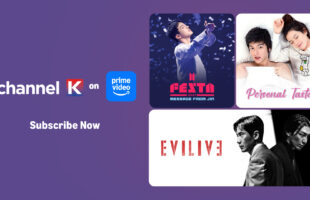
Fred Chong

WebTVAsia – Fred Chong
Is there a future for Asian digital content?
There’s the mainstream content and then, there’s the Asian digital creator’s content which is breaking new grounds today. Mainstream players are starting to embrace these new digital creators and using them to produce TV content, which is losing its ground. Asian digital content is going through a phase where creators are only given a small budget for their creative talent. But this is slowly gaining traction with higher traffic and large fan base, allowing them to become the ‘new mainstream’.
It is clear that mainstream has yet to have a firm grip of digital creators and the digital way of producing content for the new generation. The numbers don’t lie. If you put mainstream content on digital, you will get a million views. If it’s of low-quality, it gets a 100 million views. The audiences are moving towards digital. It’s only a matter of time when they will decide that they’ve had enough of mainstream media and shift their time to digital.
Is branded content the way to go?
No. I like to highlight that it could kill the creators’ creativity. Creators are not just meant to produce YouTube videos. A savvy creator could be the next Steven Spielberg. Somewhere along the lines, before they even reach that level, they are bombarded with offers from brands and suddenly they’re producing branded content because of the higher revenue. You’re now focused on how to present a brand or product in a video so that the advertiser is happy. The creative focus gets lost and that is betraying the fans, followers or creators. Creators must not forget why they’re producing videos. I also embrace branded content but I want advertisers and brands to understand that there’s more to the creators than just utilising or exploiting their fan base.
Are brands diluting the creative juice of creators?
Creators are underpaid and lack the knowledge of their demand in the industry where they are actually highly sought after. Everyone must move from YouTube to somewhere, but many are not getting anywhere. None are big stars today because they got lost along the way and branded contents have influenced their path to success for some. We want to highlight that creators can work with us and we can invest in the original content without brands so that we can create IPs for them. There may be undiscovered talent in Vietnam or Thailand who may be the next Steven Spielberg and we want to be the platform to discover them.

Where is Asian content heading?
I think Asia is still in its infancy, but it’s moving and growing very quickly. Brands are still struggling how to communicate to millennials via content marketing and branded opportunities within Asia. There’s such a drastic learning curve that is happening out there. Today, if you were to look at Singapore’s creator ecosystem, there are only three or four standout creators. Brands are hesitant to work in that space because there aren’t enough good samples. On the other hand, there are great examples from Indonesia, Korea or China, but in their local languages. The best thing that could happen is to have more creators sharing, and then brands can understand what works and what doesn’t.
Do you think mainstream content producers will make it in the digital world?
Mainstream, like Endemol Shine Group, are arguably the largest independent producer and distributor of terrestrial content. We also have a very large footprint in digital through Endemol Shine Beyond, our digital group. Television companies are investing heavily in digital production companies. Traditional TV and film stars are also becoming more active in the digital space. As Asia digitises, we’ll see a lot more traditional media companies playing in the digital space and vice versa. Long form stories could also be produced digitally.
Is branded content the way to go?
It’s not the only way or it’ll never be the only way, but it is an effective way if used properly. The holy grail on branded content is about authenticity and great storytelling. If brands trust and allow creators to do their thing without interference, that will produce a much better product, and a little stronger signal, that branded content could be the way to go. The reason why media companies and consultants are in play is because it’s a very complex market space. You have to have smart people in the right places to guide where your investments are heading and where your efforts will concentrate. Branded will be one part of that media mix, but it needs to be supported by paid media and organic shares. You really need to put the whole ecosystem together.
What is the future of Asian content?
Asian content is going to be diversified and colourful. Thanks to developments in technology, there will be more interactive communications such as Viral Fest Asia, where ideas, knowledge and operation processes are exchanged. Through such exchanges, Asian content will hit a higher note. If there’s something the West is good at, we should learn from them. And if there’s something unique to Asia or something we are good at, we’ll leverage on it. We just produced Kung Fu Panda 3 working with the West, but we still like to stick to the Eastern culture – about family and values.
Will mainstream content producers make it in the digital space and vice versa?
Netflix is already doing it. They’re producing high-quality digital content good enough to be broadcast on traditional TV. If you look at China, there is more cooperation between the digital platforms and TV channels, especially for high-quality TV dramas. These days, we have non-scripted content like variety shows where TV broadcasters work with digital broadcasters, playing different roles. When it comes to digital platforms, it’s more social media-oriented and you can interact with thousands and receive immediate attention from the audience. For broadcasters, it needs to be more scripted and edited, decent to go on air. This kind of cooperation is often used by talent shows – first round of selection is done via a digital platform and the finale show aired on TV. In order to keep the popularity of the contestants and the show, they have lots of short clips to promote the contestants.
Is branded content the way to go?
It should be more than just a sponsorship. Positioning should match and there should be more creatives to beef it up, so the story and brand can mix well. If it is creatively successful, it’ll only bring more sponsors in the future. Native advertising works best in the digital world. Now we have ‘big data’, analysis and solutions. That’s why Buzzfeed works out very well. For the advertisers, they want to spend less and get the best result from users/ consumers. It’s about pairing content with technology. As long as the brand can respect the creativity of the producer and not forcing their product in every second of the content, I think it will work well.
Is there a future for Asian content?
Asia is becoming more and more creative. Different cultures and countries can collaborate and create more content together. The challenge of a language barrier is very real, but I don’t think it should stop or limit us from creating great content. If content is done and executed well, it should be universal. Asians should be working together and looking at opportunities to scale each other up. If you take Indonesia and the Philippines, combined, we’re very massive already. In the Philippines, 70% of YouTubers’ traffic is not from Filipinos, but from others around the world. A video doesn’t have to be in English or Tagalog, but everyone is now watching it. The heart of content has always been the audience and it’s a race towards understanding the audience better. As for the younger generation, they’re looking for content that engages them, making them cry or laugh. In reality, you don’t really need a lot of words to get those emotions out of a viewer, but it’s all about how you can get that profound engagement with the audience.
Will mainstream producers make it in the digital world and vice versa?
In my experience, it’s very hard. In the Philippines, ABS-CBN is the biggest player in television and the digital space. Yet, if we create content, it will be solely for a specific platform. In an ideal world, we’ll always talk about putting digital superstars on television, but you don’t get as much traction. If you look at the TV audience base, it’s more towards the middle class. If you’re talking about the digital base, it’s all very niche and targeted content, which is a different field altogether.
Is branded content the way to go?
Yes, the challenge today is how branded content can be aired on television? In reality, you can actually maximise the entire digital platform and its creators to help with co-creation of content. They’re more flexible, easier to talk to and much cheaper. Branded content is the way to go, as users are the ones skipping the ads and the ones going to the bathroom during a commercial, so they’re not focused on advertising anymore









